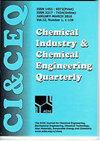微藻电化学收获的参数化与成本-效益对比研究
IF 0.8
4区 工程技术
Q4 CHEMISTRY, APPLIED
Chemical Industry & Chemical Engineering Quarterly
Pub Date : 2021-01-01
DOI:10.2298/ciceq191213031a
引用次数: 5
摘要
微藻收获的成本对生物燃料生产的商业化构成了沉重的负担。本研究通过使用牺牲电极(铝)和非牺牲电极(石墨)的电化学收集的经济和参数比较来解决这个问题。收集了收集效率、功耗和运行成本作为客观变量,作为施加电流和溶液初始pH的函数。结果表明,铝阳极在较短的电解时间内获得了较高的收获效率。可以通过增加两种电极材料的施加电流或电解时间来提高收获效率,其中可以获得98%的收获效率。结果还表明,石墨阳极的功耗高于铝阳极。然而,在0.2 A时,石墨的本地运行成本(0.036美元/立方米)明显低于铝(0.08美元/立方米)。此外,铝的初始pH为6,石墨的初始pH为4时,在较短的电解时间内收获效率达到较高的值。因此,在酸性条件下,收集过程的功耗可以降低到铝的0.46 kWh/kg左右,石墨的1.12 kWh/kg左右。本文章由计算机程序翻译,如有差异,请以英文原文为准。
Electrochemical harvesting of microalgae꞉ Parametric and cost-effectivity comparative investigation
The cost of microalgae harvesting constitutes a heavy burden on the commercialization of biofuel production. The present study addressed this problem through economic and parametric comparison of electrochemical harvesting using a sacrificial electrode (aluminum) and a nonsacrificial electrode (graphite). The harvesting efficiency, power consumption, and operation cost were collected as objective variables as a function of applied current and initial pH of the solution. The results indicated that high harvesting efficiency obtained by using aluminum anode is achieved in short electrolysis time. That harvesting efficiency can be enhanced by increasing the applied current or the electrolysis time for both electrode materials, where 98% of harvesting efficiency can be obtained. The results also demonstrated that the power consumption with the graphite anode is higher than that of aluminum. However, at 0.2 A the local cost of operation with graphite (0.036 US$/m3) is distinctly lower than that of aluminum (0.08 US$/m3). Furthermore, the harvesting efficiency reached its higher value at short electrolysis time at an initial pH of 6 for aluminum, and at an initial pH of 4 for graphite. Consequently, the power consumption of the harvesting process could be reduced at acid- nature conditions to around 0.46 kWh/kg for aluminum and 1.12 kWh/kg for graphite.
求助全文
通过发布文献求助,成功后即可免费获取论文全文。
去求助
来源期刊

Chemical Industry & Chemical Engineering Quarterly
CHEMISTRY, APPLIED-ENGINEERING, CHEMICAL
CiteScore
2.10
自引率
0.00%
发文量
24
审稿时长
3.3 months
期刊介绍:
The Journal invites contributions to the following two main areas:
• Applied Chemistry dealing with the application of basic chemical sciences to industry
• Chemical Engineering dealing with the chemical and biochemical conversion of raw materials into different products as well as the design and operation of plants and equipment.
The Journal welcomes contributions focused on:
Chemical and Biochemical Engineering [...]
Process Systems Engineering[...]
Environmental Chemical and Process Engineering[...]
Materials Synthesis and Processing[...]
Food and Bioproducts Processing[...]
Process Technology[...]
 求助内容:
求助内容: 应助结果提醒方式:
应助结果提醒方式:


